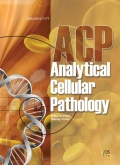Authors: Escribano, Luis | Orfao, Alberto | Villarrubia, Jesús | Díaz‐Agustín, Beatriz | Cerveró, Carlos | Rios, Agustín | Velasco, José L. | Ciudad, Juana | Navarro, José L. | San Miguel, Jesús F.
Article Type:
Research Article
Abstract:
The goal of the present paper was to define the immunophenotype of bone marrow mast cells (BMMC) from healthy controls and patients with hematologic malignancies (HM) based on the use of multiple stainings with monoclonal antibodies analyzed by flow cytometry. Our results show that BMMC from both groups of individuals display a similar but heterogenous immunophenotype. The overall numbers of BMMC are higher in the HM group of individuals (p=0.08 ). Three patterns of antigen expression were detected: (1) markers constantly positive in all cases analyzed (CD9, CD29, CD33, CD43, CD44, CD49d, CD49e, CD51, CD71, CD117, and Fc\varepsilon
…RI), (2) antigens that were constantly negative (CD1a, CD2, CD3, CD5, CD6, CD11a, CD14, CD15, CD16, CD19, CD20, CD21, CD23, CD25, CD30, CD34, CD38, CD41a, CD42b, CD65, CD66b, HLA‐DR, and CD138), and (3) markers that were positive in a variable proportion of cases – CD11b (50%), CD11c (77%), CD13 (40%), CD18 (20%), CD22 (68%), CD35 (27%), CD40 (67%), CD54 (88%) and CD61 (40%). In addition, BMMC from all cases explored were CD45^+ , and this antigen was expressed at an intensity similar to that of mature granulocytes. In summary, our results show that BMMC from both healthy controls and HM patients display a relatively heterogenous immunophenotype. Interestingly, we have observed clear differences between the immunophenotype of BMMC and MC from other tissues. This could be due either to the heterogeneity of human MC according to their tissue localization or to the sensitivity of the method used for antigen detection.
Show more
Keywords: Mast cells, immunophenotype, bone marrow, flow cytometry
Citation: Analytical Cellular Pathology,
vol. 16, no. 3, pp. 151-159, 1998
Price: EUR 27.50





